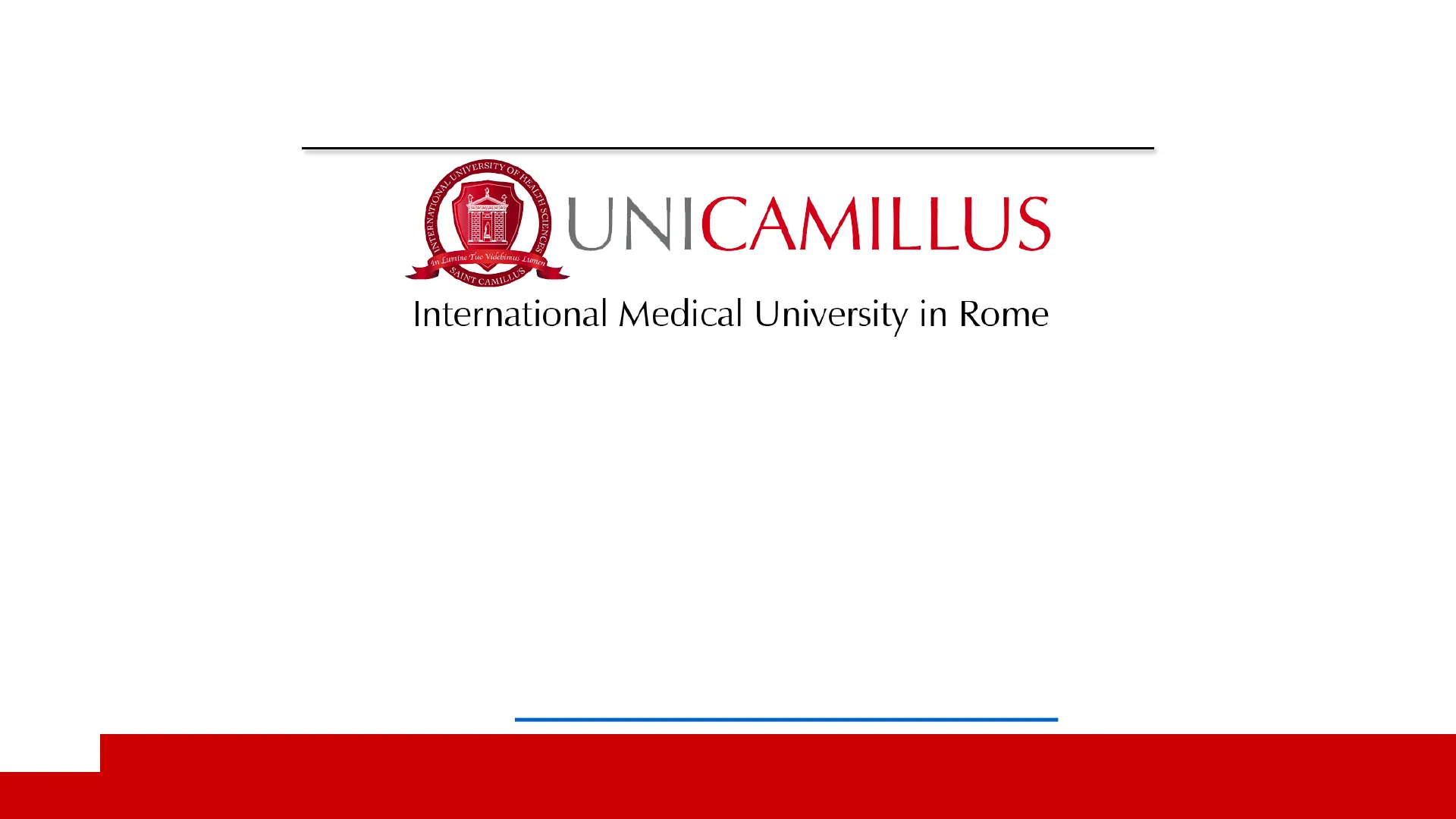Diabetes Mellitus: Definition, Etiologic Classification, and Epidemiology
Slides from Unicamillus International Medical University in Rome about Diabetes Mellitus Definition and Etiologic classification. The Pdf, a presentation for university-level Biology, covers the definition, etymology, and global epidemiology of diabetes, including prevalence of T2DM. It provides a comprehensive overview of the disease.
Ver más24 páginas


Visualiza gratis el PDF completo
Regístrate para acceder al documento completo y transformarlo con la IA.
Vista previa
Diabetes Mellitus: Definition and Etiologic Classification
IENCES In Lumine Tuo Videbimus Lumen SAINT T CAMI LUS UNICAMILLUS International Medical University in Rome Marco Infante, MD, PhD, FACN Adjunct Professor of Endocrinology and Applied Nutrition in Internal Medicine UniCamillus, Saint Camillus International University of Health Sciences, Rome Email: marco.infante@unicamillus.orgDiabetes Mellitus
Etymology of Diabetes Mellitus
Ancient Greek medical authors such as Rufus of Ephesus (c. 1st century AD) and Galen (130-c.201) were mentioning that the condition which nowadays is known as diabetes was provoking excessive thirst, polyuria, emaciation of the human body, leading sometimes to death. Later, the term "diabetes" was first introduced into medical nomenclature by Aretaeus of Cappadocia (2nd century AD).
> The term "diabetes" arises from the Greek verb "oiaBaivw" (diabaino), which means "to go through" or "to run through" and diabetes, the condition that the fluid runs through (like a siphon or a water-pipe). OF HE TH SCIENCES INTER An Lumine Tuo Videbimus Lumen SAINT CAMILLUS Karamanou et al. World J Diabetes 2016Diabetes Mellitus
Etymology and the Term "Mellitus"
OF HE TH SCIENCES INTER In Lumine Tuo Videbimus Lumen SAINT VT CAMILLUS The English anatomist and physician Thomas Willis (1621-1675) commented on the sweetness of the urine in diabetic patients, coining also the term "mellitus" (from the Latin word "mel", which means "honey"), indicating the large amounts of urine which is tasted sweet (like sugar or honey).
(бпотал VILL на Р. охоте D . Loggan: delit et feulp: ETATIS SUE, 45. Willis T Opera Omnia. Coloniae: Sumptibus Gasparis Storti, 1694: 460. Leiden: BrillDiabetes Mellitus
Definition of Diabetes Mellitus
OF HE TH SCIENCES INTER In Lumine Tuo Videbimus Lumen MILLUS Diabetes mellitus is a group of metabolic diseases characterized by hyperglycemia resulting from defects in insulin secretion, insulin action, or both. The chronic hyperglycemia of diabetes is associated with long-term damage, dysfunction, and failure of various organs, especially the eyes, kidneys, nerves, heart, and blood vessels. Diabetes Care 2004 Jan; 27(suppl 1): s5-s10.RSITY OF HE INTER An Lumine Tue Videbimus Lumen SAINT CAM
Etiologic Classification of Diabetes Mellitus
Pancreatogenic (Type 3c) Diabetes Mellitus (T3cDM)
- Type 1 Diabetesª (ß cell destruction, usually leading to absolute
insulin deficiency)
- Immune-mediated, type 1a
- Idiopathic, type 1b
- Type 2 Diabetesª (may range from predominantly insulin resistance with relative insulin deficiency to a predominantly secretory defect with minimal insulin resistance)
- Monogenic Diabetes
- Autosomal dominant genetic defects of pancreatic ß cells
- Maturity onset diabetes of the young (MODY)
- Insulin gene (INS)
- ATP-sensitive potassium channel (KCNJ11 and ABCC8)
- Other genetic defects of pancreatic ß cells
- Autosomal recessive genetic defects
- Mitochondrial DNA
- Ketosis-prone diabetes (KPD)
- Genetic defects in insulin action
- Insulin receptor mutations
- Lipoatrophic diabetes
- Neonatal diabetes (overlaps with categories A, B, C, E, and F)
- Transient
- Permanent
- Monogenic autoimmune syndromes
- IPEX: Immunodysregulation polyendocrinopathy enteropathy, X-linked
- Autoimmune polyendocrinopathy syndrome type 1
- Other autosomal recessive autoimmune polyendocrinopa- thies (IL2RA, ITCH, and LRBA)
- Other autosomal dominant autoimmune polyendocrinopa- thies (STAT1, STAT3, and SIRT1)
- Other genetic syndromes sometimes associated with diabetes
- Chromosomal defects: Down, Klinefelter, and Turner syndromes
- Neuromuscular syndromes: Friedreich ataxia, Huntington chorea, myotonic dystrophy, porphyria, and others
- Obesity syndromes: Laurence-Moon-Biedl, Bardet-Biedl, Prader-Willi syndromes, and others
- Wolfram syndrome
- Autosomal dominant genetic defects of pancreatic ß cells
- Secondary Diabetes
- Diseases of the exocrine pancreas
- Pancreatitis
- Trauma, pancreatectomy
- Neoplasia
- Cystic fibrosis
- Hemochromatosis
- Fibrocalculous pancreatopathy
- Endocrinopathies
- Acromegaly
- Cushing syndrome
- Glucagonoma
- Pheochromocytoma
- Hyperthyroidism
- Somatostatinoma
- Aldosteronoma
- Drug- or chemical-induced
- ß cell toxicity: vacor, pentamidine, cyclosporine
- ß cell autoimmunity: o-interferon, anti-PD-1, anti-PD-L1, anti-CTLA-4
- ß cell dysfunction: thiazide and loop diuretics, diazoxide, o. agonists, ß blockers, phenytoin, opiates
- Insulin resistance: glucocorticoids, progesterone, nicotinic acid, thyroid hormone, ß blockers, atypical antipsychotic drugs, antiretroviral protease inhibitors
- Infections
- Congenital rubella
- Other viruses: cytomegalovirus, coxsackievirus B, adenovirus, mumps
- Uncommon forms of immune-mediated diabetes
- Stiff-person syndrome
- Anti-insulin receptor antibodies
- POEMS syndrome
- Diseases of the exocrine pancreas
- Gestational Diabetes Mellitus (GDM)
ªPatients with any form of diabetes may require insulin treatment at some stage of their disease. Such use of insulin does not, of itself, classify the patient. Data from American Diabetes Association. Classification and Diagnosis of Diabetes. Diabetes Care. 2016 Jan;39 Suppl 1:513-22. Greenspan's Basic & Clinical Endocrinology 10th EditionRSITY OF HE INTER an Lumine Tue Videbimuss Lumea SAINT CAM
Etiologic Classification of Diabetes Mellitus: ADA Table
Table 1 Diabetes classification according to the ADA [1]
Diabetes Classification by Type
| Type | Description |
| Type 1 diabetes | Caused by autoimmune beta cell destruction, usually leading to absolute insulin deficiency |
| Type 2 diabetes | Caused by progressive loss of adequate insulin secretion, frequently with insulin resistance |
| Gestational diabetes | Diagnosed in the second or third trimesters, without overt diabetes prior to gestation |
| Monogenic diabetes | There are two subgroups: MODY and neonatal diabetes |
| Disease of the exocrine pancreas | Caused by pancreatitis, cystic fibrosis, and other disorders of the pancreas |
| Chemical or drug-induced | Caused by glucocorticoids, HIV/AIDS drugs, organ transplantation drugs |
Redondo et al. Diabetologia. 2020Diabetes Mellitus
Epidemiology of Diabetes Mellitus
OF HE TH SCIENCES INTER An Lumine Tuo Videbimus Lumen SA IT CAMILLUS The three main types of diabetes are the following: type 1 diabetes mellitus (T1DM), type 2 diabetes mellitus (T2DM), and gestational diabetes mellitus (GDM). T2DM -> accounts for approximately 90-95% of all diagnosed cases of diabetes. T1DM -> accounts for about 5-10% of all diabetes cases. Saeedi et al. Diabetes Res Clin Pract. 2019. Global and regional diabetes prevalence estimates for 2019 and projections for 2030 and 2045: Results from the International Diabetes Federation Diabetes Atlas, 9th edition.Diabetes Mellitus: Epidemiology
Global Epidemic of Diabetes
OF HE INTER An Lumine Tuo Videbimus Lumen SA MILLUS Diabetes around the world | 2021 IDF Atlas 2021 International Diabetes Federation
Number of Adults (20-79 years) with Diabetes Worldwide
| 2045 | 2030 | 2021 | |
| World | 784 million | 643 million | 537 million |
| North America & Caribbean (NAC) | 63 million | 57 million | 51 million |
| Europe (EUR) | 69 million | 61 million | 61 million |
| Western Pacific (WP) | 260 million | 238 million | 206 million |
| South & Central America (SACA) | 49 million | 40 million | 32 million |
| Africa (AFR) | 55 million | 33 million | 24 million |
| Middle East & North Africa (MENA) | 136 million | 95 million | 73 million |
| South-East Asia (SEA) | 152 million | 113 million | 90 million |
The International Diabetes Federation (IDF) estimated that the global diabetes prevalence in 20-79 year olds in 2021 was 10.5% (536.6 million people), rising to 12.2% (783.2 million) in 2045.
Highlights of Diabetes Statistics
- 537 million adults (20-79 years) are living with diabetes worldwide - 1 in 10.
- The total number of people with diabetes is predicted to rise to 643 million (1 in 9 adults) by 2030 and 784 million (1 in 8 adults) by 2045.
- 4 in 5 people with diabetes (81%) live in low income and middle-income countries.
- Diabetes caused 6.7 million deaths in 2021 - 1 every 5 seconds.
- An estimated 44% of adults living with diabetes (240 million people) are undiagnosed. Almost 90% of these people live in low income and middle-income countries.
SE Diabetes was responsible for an estimated USD 966 billion in global health expenditure in 2021. This represents a 316% increase over the last 15 years.
- 541 million adults worldwide, or 1 in 10, have impaired glucose tolerance, placing them at high risk of developing type 2 diabetes.
- 68% of adults with diabetes live in the 10 countries with the highest number of people with diabetes.
1 68% increase 1 50% increase 1 134% increase 87% increase 1 27% increase 1 46% increase T 24% 13% increase TH SCIENCES Sun et al. Diabetes Res Clin Pract. 2022 (PMID: 34879977)Diabetes Mellitus
Prevalence of T2DM
OF HE INTER TH SCIENCES An Lumine Tuo Videbimus Lumen SAINT CAMILLUS
| 56.3 | 68.9 | 22.4% |
| 36.8 | 50.4 | 37.3% |
| 34.6 | 67.9 | 96.2% |
| 72.1 | 123.0 | 70.6% |
| 19.8 | 41.5 | 109.6% |
World 2013 = 381.8 million 2035 = 591.9 million Increase = 55%
| 138.2 | 201.8 | 46.0% |
| 24.1 | 38.5 | 59.8% |
DeFronzo RA et al. Nat Rev Dis Primers 2015ITY OF HE Diabetes Mellitus DM)
Classic Symptoms and Signs of Uncontrolled Diabetes Mellitus
- Excessive urine production (polyuria)
- Excessive thirst (polydipsia)
- Blurred vision
- Paresthesias (tingling or numbness in extremities)
- Fatigue
- Increased appetite and polyphagia
. Unexplained weight loss
- Slow-healing wounds
- Skin infections
- Generalized pruritus and symptoms of candidal vaginitis (women)
. Itchy rash of the prepuce (men)
- Acute complications >
Diabetes: Know The Symptoms
Always tired. Sudden weight loss. E Sexual problems. Frequent urination. Wounds that won't heal. Always hungry. Blurry vision. Always thirsty. 33 Vaginal infections. Numb or tingling hands or feet.
The 3 P's of Diabetes
3 P: Polyuria, Polydipsia, Polyphagia
Possible Signs of Dehydration
- Dry mucous membranes
- Decreased skin turgor
- Lowered plasma volume, postural hypotension, weakness, dizziness
Diabetic ketoacidosis (DKA), Hyperosmolar hyperglycemic syndrome (HHS)/nonketotic hyperosmolar coma